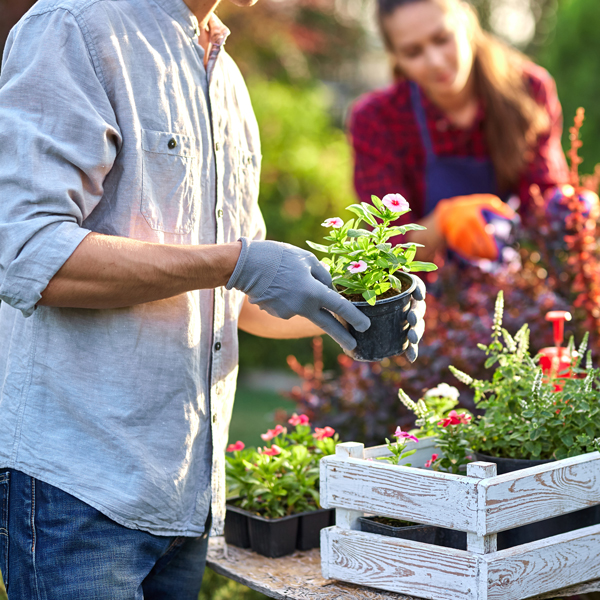From Seed to Flower: Supporting Your Interest with Home Gardening for Beginners
Wiki Article
From Seed to Grow: A Novice's Overview to Gardening Success

Selecting the Right Seeds
To make sure a successful garden, you require to choose the right seeds for your expanding problems and preferred plants. Various plants prosper in various climates, so it's essential to pick seeds that are appropriate for your details region. On the various other hand, if you live in a cooler climate with much shorter expanding seasons, look for seeds that have a much shorter maturity duration.Some plants prefer sandy soil, while others prosper in clay or fertile soil. Some plants, like tomatoes and peppers, require complete sunlight to prosper, while others, such as leafy eco-friendlies, can endure partial color.
If you're interested in blossoms, choose seeds for plants that will complement each other in terms of flower, height, and color time. By carefully picking the ideal seeds for your expanding conditions and wanted plants, you'll set on your own up for a successful yard.
Preparing the Dirt
Now that you've selected the appropriate seeds for your yard, it's time to prepare the soil for ideal growth. Preparing the dirt is a crucial action in gardening success, as it supplies the foundation for your plants to prosper.Start by eliminating any kind of weeds or debris from the location where you plan to plant (gardening for beginners). Weeds can contend with your plants for nutrients and water, so it is essential to eliminate them prior to planting. Utilize a yard fork or hoe to loosen the soil, damaging up any clumps and developing a loose, crunchy texture
Spread a layer of natural issue over the soil and utilize a yard fork or rake to incorporate it into the top couple of inches. This will certainly help improve drain, dampness retention, and nutrient accessibility for your plants.
Most plants choose a somewhat acidic to neutral pH, around 6.0 to 7.0. You can buy a dirt screening package from a yard facility or send a sample to a lab for analysis.
Growing and Watering Strategies
When it comes to growing, make certain to follow the guidelines on the seed packages or plant labels. Various plants have different requirements for growing depth and spacing.Watering is a critical action in gardening. It is necessary to water your plants correctly to advertise healthy development. The secret is to offer adequate water without drowning the plants. When watering, aim to dampen the soil uniformly, guaranteeing that the water gets to the plant's roots. Avoid overwatering, as this can cause root rot and other troubles. A good general rule is to water Get the facts deeply however much less often, permitting the soil to dry slightly in between watering sessions.
To establish when to water, inspect the dampness degree of the soil by putting your finger about an inch deep. It's time to water if it feels completely dry. Consider utilizing a watering can or a hose with a mild spray nozzle to prevent destructive delicate plants.
Nurturing and Preserving Your Yard
Nurturing and maintaining your garden is critical in order to keep your plants flourishing and healthy. Routinely remove any type of undesirable plants that may compete with your yard for nutrients and space. Using a layer of mulch around your plants aids preserve wetness, suppress weeds, and manage dirt temperature level.Harvesting and Enjoying the Fruits of Your Labor
When Recommended Site can you start enjoying the incentives of your effort in the garden? The answer depends on the kind of plants you have actually expanded. Some veggies, like lettuce and radishes, can be collected as soon as they get to a preferable dimension (gardening kit for beginners). Others, such as peppers and tomatoes, require a longer expanding season before they are prepared to be picked.To establish if your vegetables are ready for harvest, you need to try to find certain indications. Ripe tomatoes will certainly be firm and have a deep, dynamic shade. They need to quickly remove from the creeping plant when carefully drawn. Peppers, on the various other hand, ought to be plump and have a shiny look.
When harvesting, it is necessary to utilize the correct devices and techniques. A sharp set of pruning shears or a yard knife can be used to cleanly reduce vegetables from the plant. Make sure to gather in the morning when the temperature levels are cooler, as this will certainly help maintain the quality of your produce.
When you have harvested your vegetables, it's time to enjoy the fruits of your labor. Fresh picked vegetables can be used in a selection of delicious meals, from salads to stir-fries. Alternatively, you can preserve your harvest by canning, freezing, or drying them to take pleasure in throughout the year.

Conclusion
Congratulations! You have now learned the important actions to achieve gardening success, from selecting the appropriate seeds to gathering the fruits of your labor. By following these beginner-friendly techniques, you are well on your way to supporting a flourishing yard. Remember to offer your plants the care and interest they require, and soon you will be enjoying the charm and bounty of your really own garden. Happy horticulture!To guarantee an effective yard, you require to select the best seeds for your growing problems and desired plants. By carefully picking visit here the best seeds for your growing conditions and preferred plants, you'll establish on your own up for an effective garden.
Weeds can contend with your plants for nutrients and water, so it's important to obtain rid of them before planting. When it comes to planting, make sure to adhere to the directions on the seed packets or plant tags. Different plants have various needs for planting depth and spacing.
Report this wiki page